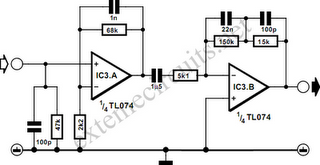Home » Circuits
RIAA Phono Preamplifier
Since modern sound systems usually lack inputs for record players, separate MD preamplifiers are becoming increasingly popular. They are needed not only by people who still regularly like to listen to vinyl records, but also by those who want to finally transcribe their LP collections to CD using a CD recorder. The author has built innumerable phono preamplifiers for friends and acquaintances. In many cases, for the sake of simplicity these were based on an old circuit design with two µA741s, which was originally described by B. Wolfenden in a 1976 issue of Wireless World.In that simple design, the first 741 simply amplified the full range of the frequency spectrum, while the second one was fitted with RIAA frequency compensation — a fairly common configuration at that time. However, a variant on this classic design was recently born after a bit of experimenting. It also uses two opamps, with the difference that the RIAA frequency compensation is distributed over both opamps. The accompanying figure shows the schematic diagram of this preamplifier. The first opamp attenuates the signal at 6 dB/octave starting at 2.2 kHz, while the second opamp looks after the other corner frequency.

The objective of the new design was to keep the feedback factor as high as possible in both stages. To the considerable surprise of the developer, this modification turned out to have an unexpected side effect: when records were played, certain scratches were no longer audible! The difference between the new and old preamplifiers could be clearly heard; it was certainly not just imagination. What could be the cause of this? A quick calculation showed that a 0.05-mm scratch in a record groove moving past a needle at a speed of 0.5 m/s produces a square-wave pulse with a frequency of 10 kHz. Evidently, there is a lot to be gained by attenuating such pulses with a low-pass filter as early as possible, which means in the first stage, in order to prevent them from over-driving the rest of the circuit.
